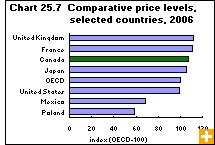Common menu bar links
Purchasing power parities
Archived Content
Information identified as archived is provided for reference, research or recordkeeping purposes. It is not subject to the Government of Canada Web Standards and has not been altered or updated since it was archived. Please contact us to request a format other than those available.
Would a cup of coffee cost more in Paris than at your favourite local drive-through? A statistical tool called purchasing power parities (PPP) helps to answer this and similar questions because it compares the purchasing power of different countries’ currencies.
For example, if the price of a coffee is 2 euros in France and $3 in Canada, then the PPP between the two countries would be $3 divided by 2—in other words, for every euro needed to buy a coffee in France, you would need $1.50 in Canada.
In reality, though, many more goods and services are exchanged in an economy than just cups of coffee. That is why PPP estimates in practice cover a wide-ranging basket of more than 3,000 goods and services.
The Organisation for Economic Co-operation and Development (OECD) calculated 2006 PPP estimates for Canada. These showed that $CAN1.23 in Canada has the same purchasing power as $US1.00 in the United States or 0.89 euros in France—the U.S. dollar is the reference currency.
Other interesting economic statistics can be derived from PPPs, such as comparative price levels. For instance, an index of 107 for Canada would mean that the same basket of goods and services cost 7% more in Canada in 2006 compared with the OECD average, which is set at 100.
PPPs can also be used to make meaningful comparisons of countries’ economic output. For instance, the PPP-adjusted estimate of gross domestic product per person of 118 for Canada in 2006 means that Canadians produce 18% more goods and services per person than the OECD average.



